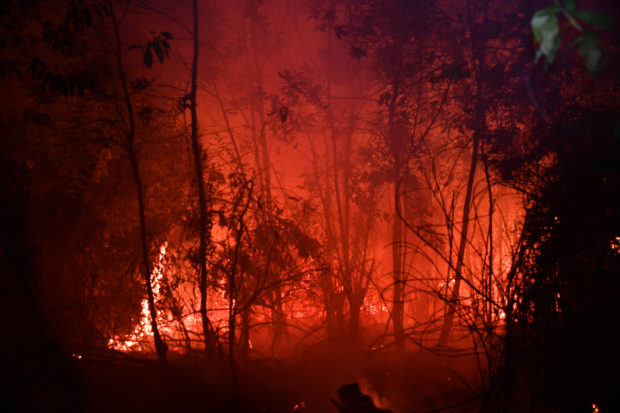Asia suffered hottest year on record in 2020–UN

A fire burn in a land next to residence in Pekanbaru, Riau province, on September 13, 2019 as the number of blazes in Indonesia’s rainforests has jumped sharply, satellite data showed on September 12, spreading smog across Southeast Asia and adding to concerns about the impact of increasing wildfire outbreaks worldwide on global warming. AFP FILE PHOTO
GENEVA — Asia suffered its hottest year on record in 2020, the United Nations said Tuesday ahead of the COP26 summit, with extreme weather taking a heavy toll on the continent’s development.
In its annual “State of the Climate in Asia” report, the UN’s World Meteorological Organization said every part of the region had been affected.
“Extreme weather and climate change impacts across Asia in 2020 caused the loss of life of thousands of people, displaced millions of others and cost hundreds of billions of dollars, while wreaking a heavy toll on infrastructure and ecosystems,” the WMO said.
“Sustainable development is threatened, with food and water insecurity, health risks and environmental degradation on the rise.”
The report comes days before COP26, the UN Climate Change Conference being held in Glasgow from Sunday to November 12.
Article continues after this advertisementThe report also laid bare the total annual average losses due to climate-related hazards.
Article continues after this advertisementChina suffered an estimated $238 billion, followed by India at $87 billion, Japan with $83 billion and South Korea on $24 billion.
But when the size of the economy is considered, the average annual losses are expected to be as high as 7.9 percent of gross domestic product for Tajikistan, 5.9 percent for Cambodia and 5.8 percent for Laos.
Prolonged displacement
Increased heat and humidity are forecast to lead to an effective loss of outdoor working hours across the continent, with a potential cost of many billions of dollars.
“Weather and climate hazards, especially floods, storms, and droughts, had significant impacts in many countries of the region,” said WMO chief Petteri Taalas.
“Combined, these impacts take a significant toll on long-term sustainable development.”
Many weather and climate-related displacements in Asia are prolonged, with people unable to return home or integrate locally, the report said.
In 2020 floods and storms affected approximately 50 million people in Asia, resulting in more than 5,000 fatalities.
This is below the annual average of the last two decades (158 million people affected and about 15,500 fatalities) “and is testimony to the success of early warning systems in many countries in Asia”, with around seven in 10 people covered.
Asia’s warmest year on record saw the mean temperature 1.39 degrees Celsius above the 1981–2010 average.
The 38.0 C registered at Verkhoyansk in Russia is provisionally the highest known temperature anywhere north of the Arctic Circle.
Glaciers shrinking
In 2020, average sea surface temperatures reached record high values in the Indian, Pacific and Arctic Oceans.
Sea surface temperatures and ocean warming in and around Asia are increasing more than the global average.
They have been warming at more than triple the average in the Arabian sea, and parts of the Arctic Ocean.
Arctic sea ice minimum extent (after the summer melt) in 2020 was the second lowest on the satellite record since 1979.
There are approximately 100,000 square kilometers of glaciers on the Tibetan Plateau and in the Himalayas — the largest volumes of ice outside the polar regions and the source of 10 major Asian rivers.
“Glacier retreat is accelerating and it is projected that glacier mass will decrease by 20 percent to 40 percent by 2050, affecting the lives and livelihoods of about 750 million people in the region,” the report said.
“This has major ramifications for global sea level, regional water cycles and local hazards such as landslides and avalanches.”
A quarter of Asia’s mangroves are in Bangladesh. However, the tropical storm-exposed country’s mangroves decreased by 19 percent from 1992 to 2019, the report said.